Brain Disease Model of Addiction: Treatment and Criticism
VerifiedAdded on 2022/11/19
|9
|2569
|124
Essay
AI Summary
This essay delves into the brain disease model of addiction, examining its implications for treatment and public health. It begins by defining addiction and highlighting various treatment methods, including behavioral counseling, medication, and medical devices like the NSS-2 Bridge. The essay then explores the brain disease model, which posits that addiction is a neurological disorder characterized by changes in brain structure and function. The essay discusses how this model influences treatment approaches, viewing alcoholism as an illness influenced by genetic, biological, and environmental factors. The essay then critically analyzes the criticisms of the brain disease model, such as the argument that many individuals recover without treatment. It presents counter-arguments, emphasizing the biological basis of addiction and the potential for reducing stigma and encouraging treatment. The essay concludes by acknowledging the ongoing debate surrounding the model and the need for further research to fully understand its effectiveness.
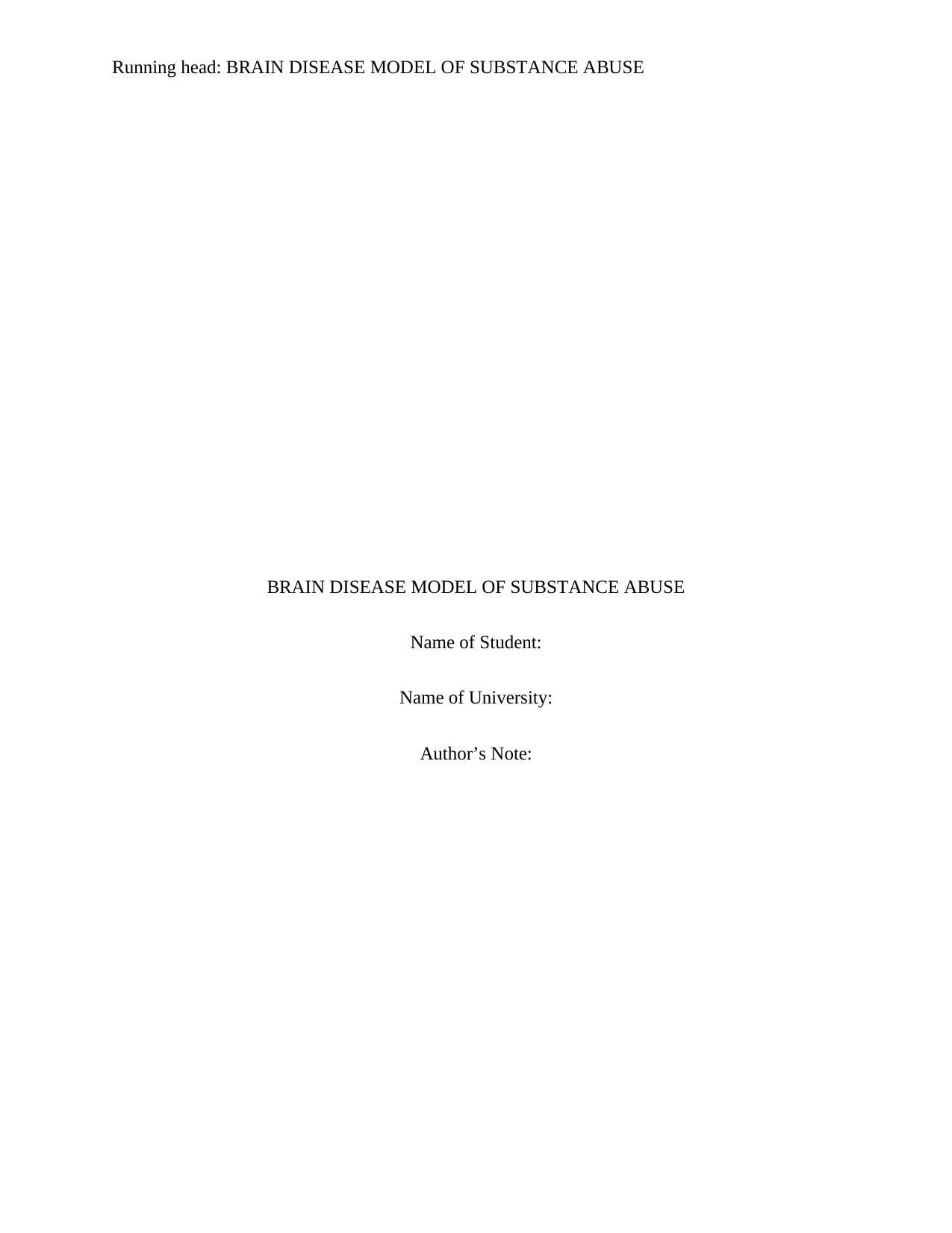
Running head: BRAIN DISEASE MODEL OF SUBSTANCE ABUSE
BRAIN DISEASE MODEL OF SUBSTANCE ABUSE
Name of Student:
Name of University:
Author’s Note:
BRAIN DISEASE MODEL OF SUBSTANCE ABUSE
Name of Student:
Name of University:
Author’s Note:
Paraphrase This Document
Need a fresh take? Get an instant paraphrase of this document with our AI Paraphraser
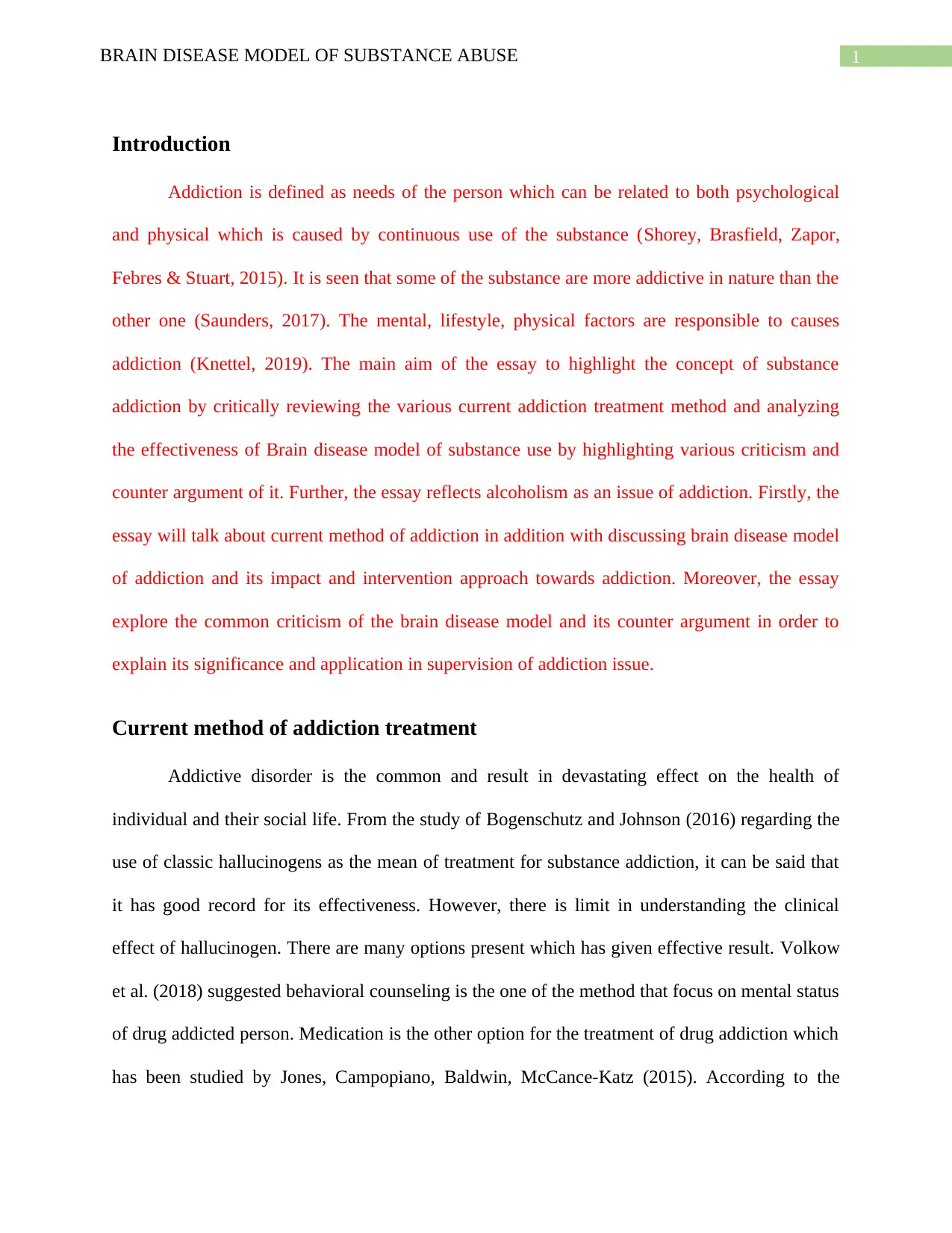
1BRAIN DISEASE MODEL OF SUBSTANCE ABUSE
Introduction
Addiction is defined as needs of the person which can be related to both psychological
and physical which is caused by continuous use of the substance (Shorey, Brasfield, Zapor,
Febres & Stuart, 2015). It is seen that some of the substance are more addictive in nature than the
other one (Saunders, 2017). The mental, lifestyle, physical factors are responsible to causes
addiction (Knettel, 2019). The main aim of the essay to highlight the concept of substance
addiction by critically reviewing the various current addiction treatment method and analyzing
the effectiveness of Brain disease model of substance use by highlighting various criticism and
counter argument of it. Further, the essay reflects alcoholism as an issue of addiction. Firstly, the
essay will talk about current method of addiction in addition with discussing brain disease model
of addiction and its impact and intervention approach towards addiction. Moreover, the essay
explore the common criticism of the brain disease model and its counter argument in order to
explain its significance and application in supervision of addiction issue.
Current method of addiction treatment
Addictive disorder is the common and result in devastating effect on the health of
individual and their social life. From the study of Bogenschutz and Johnson (2016) regarding the
use of classic hallucinogens as the mean of treatment for substance addiction, it can be said that
it has good record for its effectiveness. However, there is limit in understanding the clinical
effect of hallucinogen. There are many options present which has given effective result. Volkow
et al. (2018) suggested behavioral counseling is the one of the method that focus on mental status
of drug addicted person. Medication is the other option for the treatment of drug addiction which
has been studied by Jones, Campopiano, Baldwin, McCance-Katz (2015). According to the
Introduction
Addiction is defined as needs of the person which can be related to both psychological
and physical which is caused by continuous use of the substance (Shorey, Brasfield, Zapor,
Febres & Stuart, 2015). It is seen that some of the substance are more addictive in nature than the
other one (Saunders, 2017). The mental, lifestyle, physical factors are responsible to causes
addiction (Knettel, 2019). The main aim of the essay to highlight the concept of substance
addiction by critically reviewing the various current addiction treatment method and analyzing
the effectiveness of Brain disease model of substance use by highlighting various criticism and
counter argument of it. Further, the essay reflects alcoholism as an issue of addiction. Firstly, the
essay will talk about current method of addiction in addition with discussing brain disease model
of addiction and its impact and intervention approach towards addiction. Moreover, the essay
explore the common criticism of the brain disease model and its counter argument in order to
explain its significance and application in supervision of addiction issue.
Current method of addiction treatment
Addictive disorder is the common and result in devastating effect on the health of
individual and their social life. From the study of Bogenschutz and Johnson (2016) regarding the
use of classic hallucinogens as the mean of treatment for substance addiction, it can be said that
it has good record for its effectiveness. However, there is limit in understanding the clinical
effect of hallucinogen. There are many options present which has given effective result. Volkow
et al. (2018) suggested behavioral counseling is the one of the method that focus on mental status
of drug addicted person. Medication is the other option for the treatment of drug addiction which
has been studied by Jones, Campopiano, Baldwin, McCance-Katz (2015). According to the
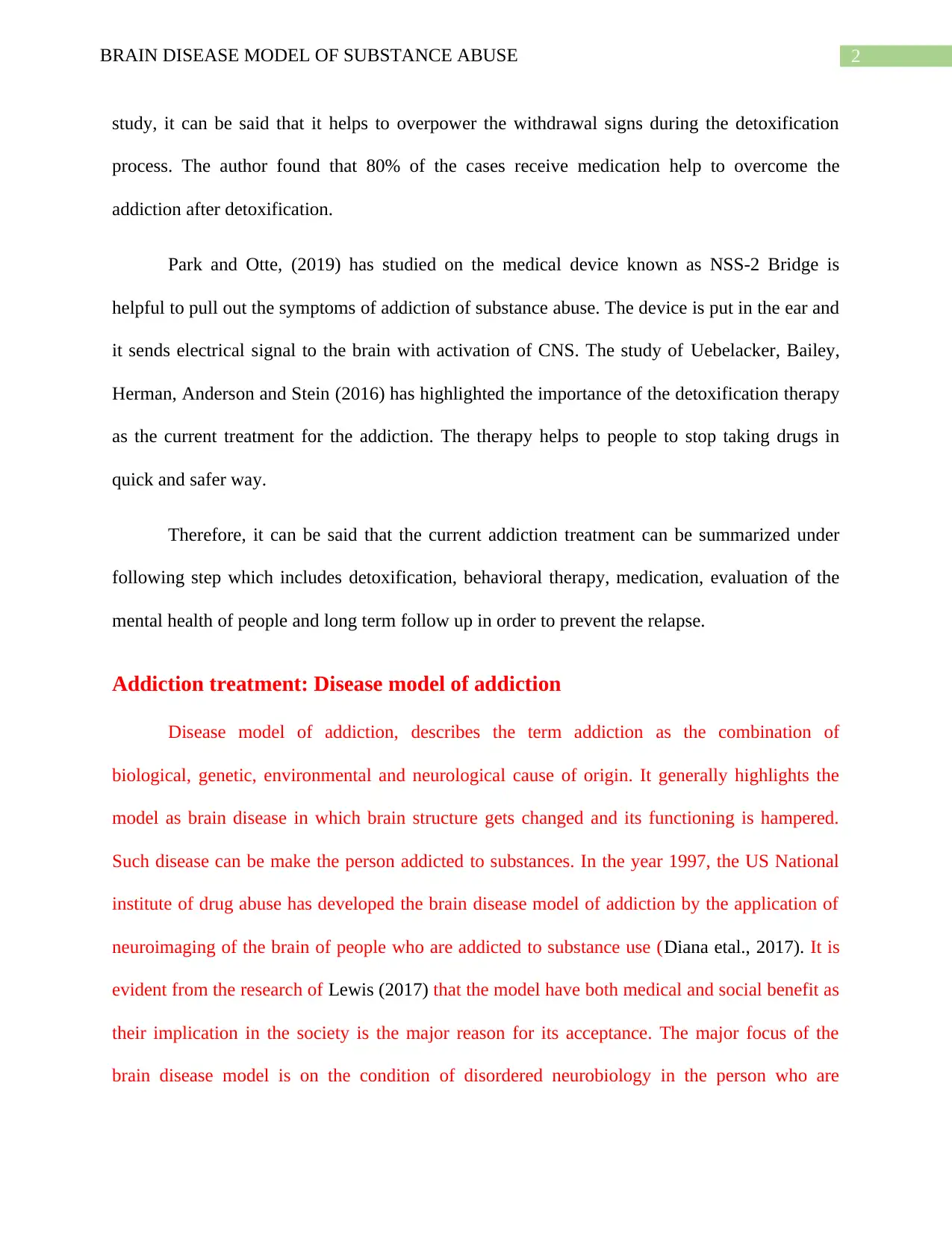
2BRAIN DISEASE MODEL OF SUBSTANCE ABUSE
study, it can be said that it helps to overpower the withdrawal signs during the detoxification
process. The author found that 80% of the cases receive medication help to overcome the
addiction after detoxification.
Park and Otte, (2019) has studied on the medical device known as NSS-2 Bridge is
helpful to pull out the symptoms of addiction of substance abuse. The device is put in the ear and
it sends electrical signal to the brain with activation of CNS. The study of Uebelacker, Bailey,
Herman, Anderson and Stein (2016) has highlighted the importance of the detoxification therapy
as the current treatment for the addiction. The therapy helps to people to stop taking drugs in
quick and safer way.
Therefore, it can be said that the current addiction treatment can be summarized under
following step which includes detoxification, behavioral therapy, medication, evaluation of the
mental health of people and long term follow up in order to prevent the relapse.
Addiction treatment: Disease model of addiction
Disease model of addiction, describes the term addiction as the combination of
biological, genetic, environmental and neurological cause of origin. It generally highlights the
model as brain disease in which brain structure gets changed and its functioning is hampered.
Such disease can be make the person addicted to substances. In the year 1997, the US National
institute of drug abuse has developed the brain disease model of addiction by the application of
neuroimaging of the brain of people who are addicted to substance use (Diana etal., 2017). It is
evident from the research of Lewis (2017) that the model have both medical and social benefit as
their implication in the society is the major reason for its acceptance. The major focus of the
brain disease model is on the condition of disordered neurobiology in the person who are
study, it can be said that it helps to overpower the withdrawal signs during the detoxification
process. The author found that 80% of the cases receive medication help to overcome the
addiction after detoxification.
Park and Otte, (2019) has studied on the medical device known as NSS-2 Bridge is
helpful to pull out the symptoms of addiction of substance abuse. The device is put in the ear and
it sends electrical signal to the brain with activation of CNS. The study of Uebelacker, Bailey,
Herman, Anderson and Stein (2016) has highlighted the importance of the detoxification therapy
as the current treatment for the addiction. The therapy helps to people to stop taking drugs in
quick and safer way.
Therefore, it can be said that the current addiction treatment can be summarized under
following step which includes detoxification, behavioral therapy, medication, evaluation of the
mental health of people and long term follow up in order to prevent the relapse.
Addiction treatment: Disease model of addiction
Disease model of addiction, describes the term addiction as the combination of
biological, genetic, environmental and neurological cause of origin. It generally highlights the
model as brain disease in which brain structure gets changed and its functioning is hampered.
Such disease can be make the person addicted to substances. In the year 1997, the US National
institute of drug abuse has developed the brain disease model of addiction by the application of
neuroimaging of the brain of people who are addicted to substance use (Diana etal., 2017). It is
evident from the research of Lewis (2017) that the model have both medical and social benefit as
their implication in the society is the major reason for its acceptance. The major focus of the
brain disease model is on the condition of disordered neurobiology in the person who are
⊘ This is a preview!⊘
Do you want full access?
Subscribe today to unlock all pages.

Trusted by 1+ million students worldwide
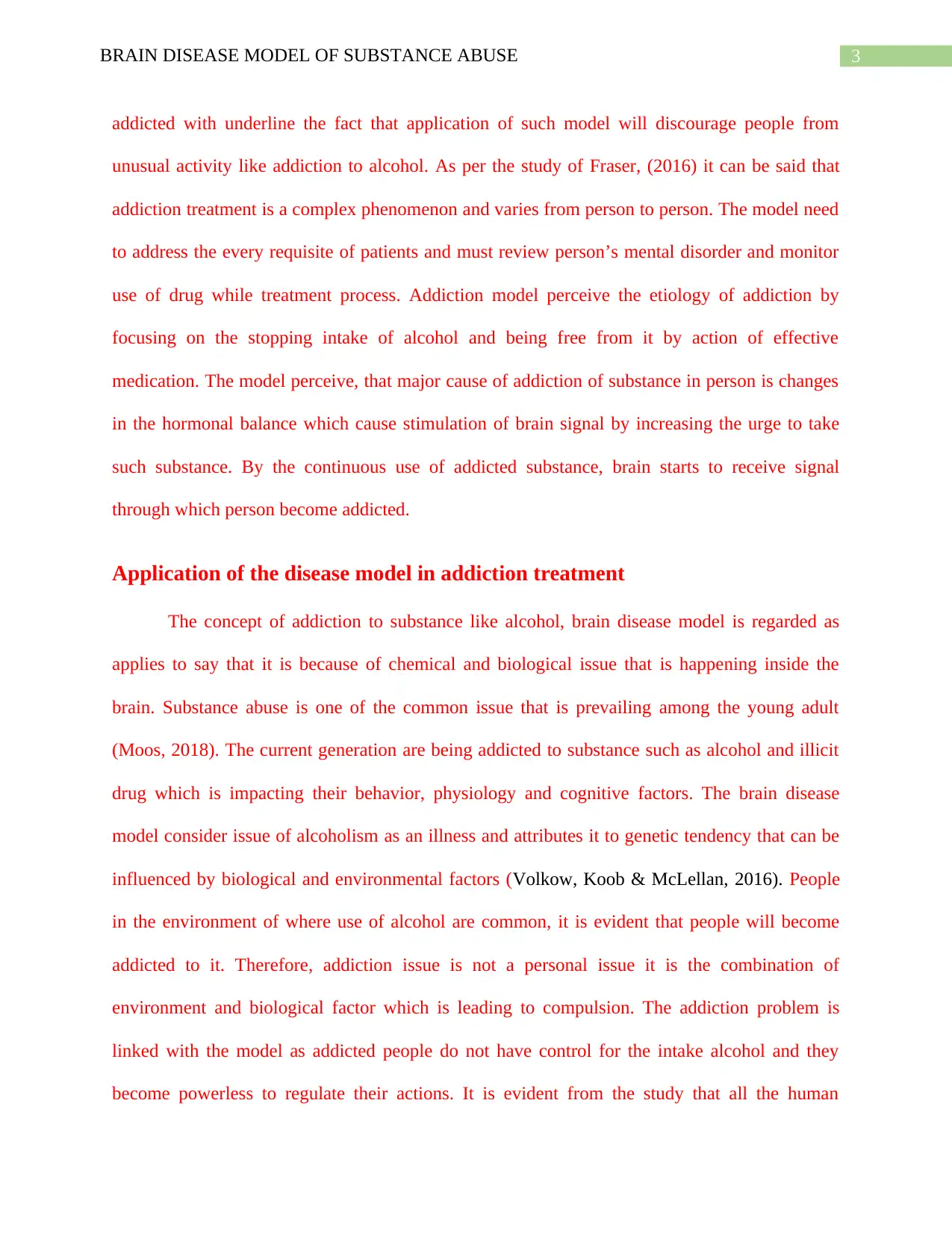
3BRAIN DISEASE MODEL OF SUBSTANCE ABUSE
addicted with underline the fact that application of such model will discourage people from
unusual activity like addiction to alcohol. As per the study of Fraser, (2016) it can be said that
addiction treatment is a complex phenomenon and varies from person to person. The model need
to address the every requisite of patients and must review person’s mental disorder and monitor
use of drug while treatment process. Addiction model perceive the etiology of addiction by
focusing on the stopping intake of alcohol and being free from it by action of effective
medication. The model perceive, that major cause of addiction of substance in person is changes
in the hormonal balance which cause stimulation of brain signal by increasing the urge to take
such substance. By the continuous use of addicted substance, brain starts to receive signal
through which person become addicted.
Application of the disease model in addiction treatment
The concept of addiction to substance like alcohol, brain disease model is regarded as
applies to say that it is because of chemical and biological issue that is happening inside the
brain. Substance abuse is one of the common issue that is prevailing among the young adult
(Moos, 2018). The current generation are being addicted to substance such as alcohol and illicit
drug which is impacting their behavior, physiology and cognitive factors. The brain disease
model consider issue of alcoholism as an illness and attributes it to genetic tendency that can be
influenced by biological and environmental factors (Volkow, Koob & McLellan, 2016). People
in the environment of where use of alcohol are common, it is evident that people will become
addicted to it. Therefore, addiction issue is not a personal issue it is the combination of
environment and biological factor which is leading to compulsion. The addiction problem is
linked with the model as addicted people do not have control for the intake alcohol and they
become powerless to regulate their actions. It is evident from the study that all the human
addicted with underline the fact that application of such model will discourage people from
unusual activity like addiction to alcohol. As per the study of Fraser, (2016) it can be said that
addiction treatment is a complex phenomenon and varies from person to person. The model need
to address the every requisite of patients and must review person’s mental disorder and monitor
use of drug while treatment process. Addiction model perceive the etiology of addiction by
focusing on the stopping intake of alcohol and being free from it by action of effective
medication. The model perceive, that major cause of addiction of substance in person is changes
in the hormonal balance which cause stimulation of brain signal by increasing the urge to take
such substance. By the continuous use of addicted substance, brain starts to receive signal
through which person become addicted.
Application of the disease model in addiction treatment
The concept of addiction to substance like alcohol, brain disease model is regarded as
applies to say that it is because of chemical and biological issue that is happening inside the
brain. Substance abuse is one of the common issue that is prevailing among the young adult
(Moos, 2018). The current generation are being addicted to substance such as alcohol and illicit
drug which is impacting their behavior, physiology and cognitive factors. The brain disease
model consider issue of alcoholism as an illness and attributes it to genetic tendency that can be
influenced by biological and environmental factors (Volkow, Koob & McLellan, 2016). People
in the environment of where use of alcohol are common, it is evident that people will become
addicted to it. Therefore, addiction issue is not a personal issue it is the combination of
environment and biological factor which is leading to compulsion. The addiction problem is
linked with the model as addicted people do not have control for the intake alcohol and they
become powerless to regulate their actions. It is evident from the study that all the human
Paraphrase This Document
Need a fresh take? Get an instant paraphrase of this document with our AI Paraphraser
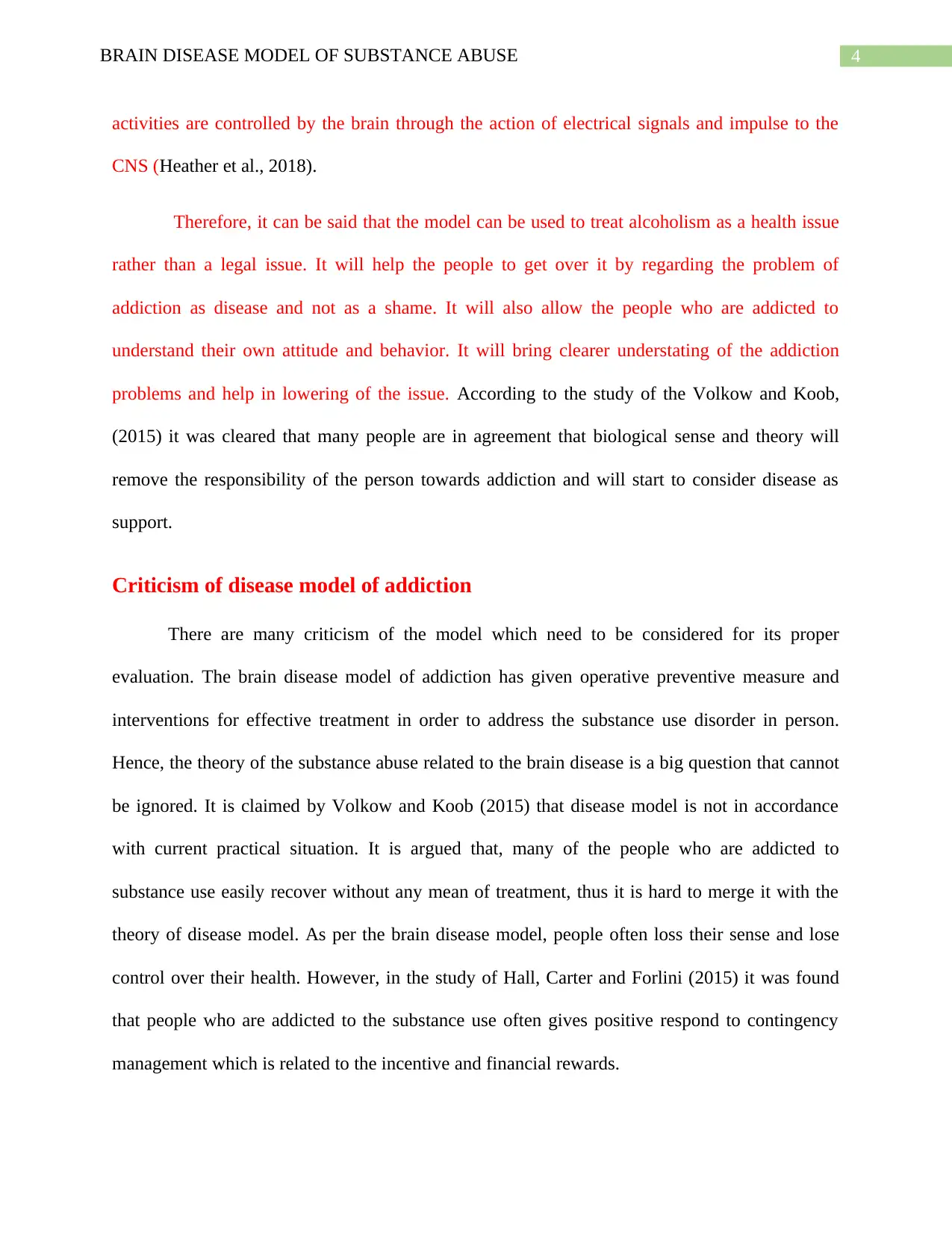
4BRAIN DISEASE MODEL OF SUBSTANCE ABUSE
activities are controlled by the brain through the action of electrical signals and impulse to the
CNS (Heather et al., 2018).
Therefore, it can be said that the model can be used to treat alcoholism as a health issue
rather than a legal issue. It will help the people to get over it by regarding the problem of
addiction as disease and not as a shame. It will also allow the people who are addicted to
understand their own attitude and behavior. It will bring clearer understating of the addiction
problems and help in lowering of the issue. According to the study of the Volkow and Koob,
(2015) it was cleared that many people are in agreement that biological sense and theory will
remove the responsibility of the person towards addiction and will start to consider disease as
support.
Criticism of disease model of addiction
There are many criticism of the model which need to be considered for its proper
evaluation. The brain disease model of addiction has given operative preventive measure and
interventions for effective treatment in order to address the substance use disorder in person.
Hence, the theory of the substance abuse related to the brain disease is a big question that cannot
be ignored. It is claimed by Volkow and Koob (2015) that disease model is not in accordance
with current practical situation. It is argued that, many of the people who are addicted to
substance use easily recover without any mean of treatment, thus it is hard to merge it with the
theory of disease model. As per the brain disease model, people often loss their sense and lose
control over their health. However, in the study of Hall, Carter and Forlini (2015) it was found
that people who are addicted to the substance use often gives positive respond to contingency
management which is related to the incentive and financial rewards.
activities are controlled by the brain through the action of electrical signals and impulse to the
CNS (Heather et al., 2018).
Therefore, it can be said that the model can be used to treat alcoholism as a health issue
rather than a legal issue. It will help the people to get over it by regarding the problem of
addiction as disease and not as a shame. It will also allow the people who are addicted to
understand their own attitude and behavior. It will bring clearer understating of the addiction
problems and help in lowering of the issue. According to the study of the Volkow and Koob,
(2015) it was cleared that many people are in agreement that biological sense and theory will
remove the responsibility of the person towards addiction and will start to consider disease as
support.
Criticism of disease model of addiction
There are many criticism of the model which need to be considered for its proper
evaluation. The brain disease model of addiction has given operative preventive measure and
interventions for effective treatment in order to address the substance use disorder in person.
Hence, the theory of the substance abuse related to the brain disease is a big question that cannot
be ignored. It is claimed by Volkow and Koob (2015) that disease model is not in accordance
with current practical situation. It is argued that, many of the people who are addicted to
substance use easily recover without any mean of treatment, thus it is hard to merge it with the
theory of disease model. As per the brain disease model, people often loss their sense and lose
control over their health. However, in the study of Hall, Carter and Forlini (2015) it was found
that people who are addicted to the substance use often gives positive respond to contingency
management which is related to the incentive and financial rewards.
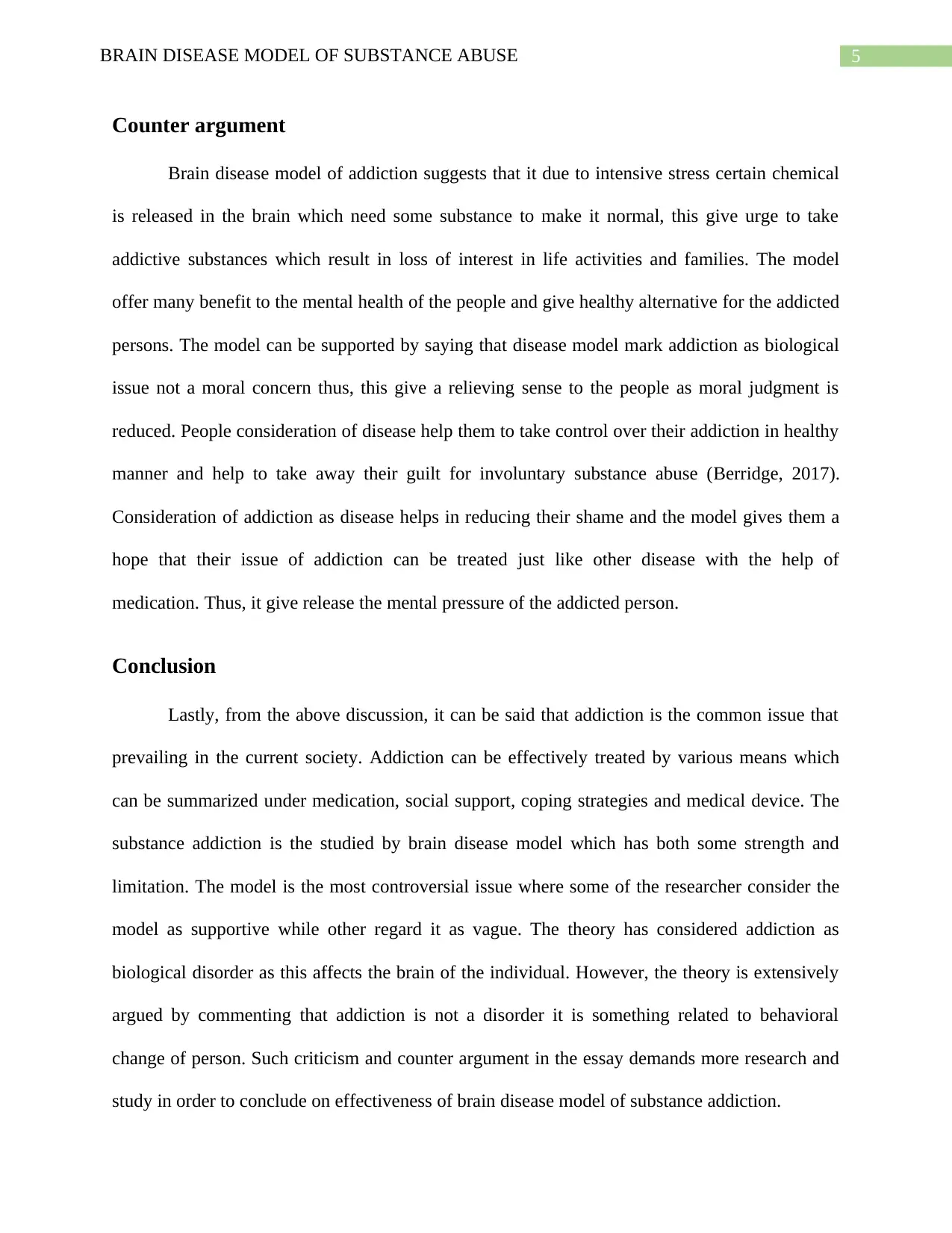
5BRAIN DISEASE MODEL OF SUBSTANCE ABUSE
Counter argument
Brain disease model of addiction suggests that it due to intensive stress certain chemical
is released in the brain which need some substance to make it normal, this give urge to take
addictive substances which result in loss of interest in life activities and families. The model
offer many benefit to the mental health of the people and give healthy alternative for the addicted
persons. The model can be supported by saying that disease model mark addiction as biological
issue not a moral concern thus, this give a relieving sense to the people as moral judgment is
reduced. People consideration of disease help them to take control over their addiction in healthy
manner and help to take away their guilt for involuntary substance abuse (Berridge, 2017).
Consideration of addiction as disease helps in reducing their shame and the model gives them a
hope that their issue of addiction can be treated just like other disease with the help of
medication. Thus, it give release the mental pressure of the addicted person.
Conclusion
Lastly, from the above discussion, it can be said that addiction is the common issue that
prevailing in the current society. Addiction can be effectively treated by various means which
can be summarized under medication, social support, coping strategies and medical device. The
substance addiction is the studied by brain disease model which has both some strength and
limitation. The model is the most controversial issue where some of the researcher consider the
model as supportive while other regard it as vague. The theory has considered addiction as
biological disorder as this affects the brain of the individual. However, the theory is extensively
argued by commenting that addiction is not a disorder it is something related to behavioral
change of person. Such criticism and counter argument in the essay demands more research and
study in order to conclude on effectiveness of brain disease model of substance addiction.
Counter argument
Brain disease model of addiction suggests that it due to intensive stress certain chemical
is released in the brain which need some substance to make it normal, this give urge to take
addictive substances which result in loss of interest in life activities and families. The model
offer many benefit to the mental health of the people and give healthy alternative for the addicted
persons. The model can be supported by saying that disease model mark addiction as biological
issue not a moral concern thus, this give a relieving sense to the people as moral judgment is
reduced. People consideration of disease help them to take control over their addiction in healthy
manner and help to take away their guilt for involuntary substance abuse (Berridge, 2017).
Consideration of addiction as disease helps in reducing their shame and the model gives them a
hope that their issue of addiction can be treated just like other disease with the help of
medication. Thus, it give release the mental pressure of the addicted person.
Conclusion
Lastly, from the above discussion, it can be said that addiction is the common issue that
prevailing in the current society. Addiction can be effectively treated by various means which
can be summarized under medication, social support, coping strategies and medical device. The
substance addiction is the studied by brain disease model which has both some strength and
limitation. The model is the most controversial issue where some of the researcher consider the
model as supportive while other regard it as vague. The theory has considered addiction as
biological disorder as this affects the brain of the individual. However, the theory is extensively
argued by commenting that addiction is not a disorder it is something related to behavioral
change of person. Such criticism and counter argument in the essay demands more research and
study in order to conclude on effectiveness of brain disease model of substance addiction.
⊘ This is a preview!⊘
Do you want full access?
Subscribe today to unlock all pages.

Trusted by 1+ million students worldwide
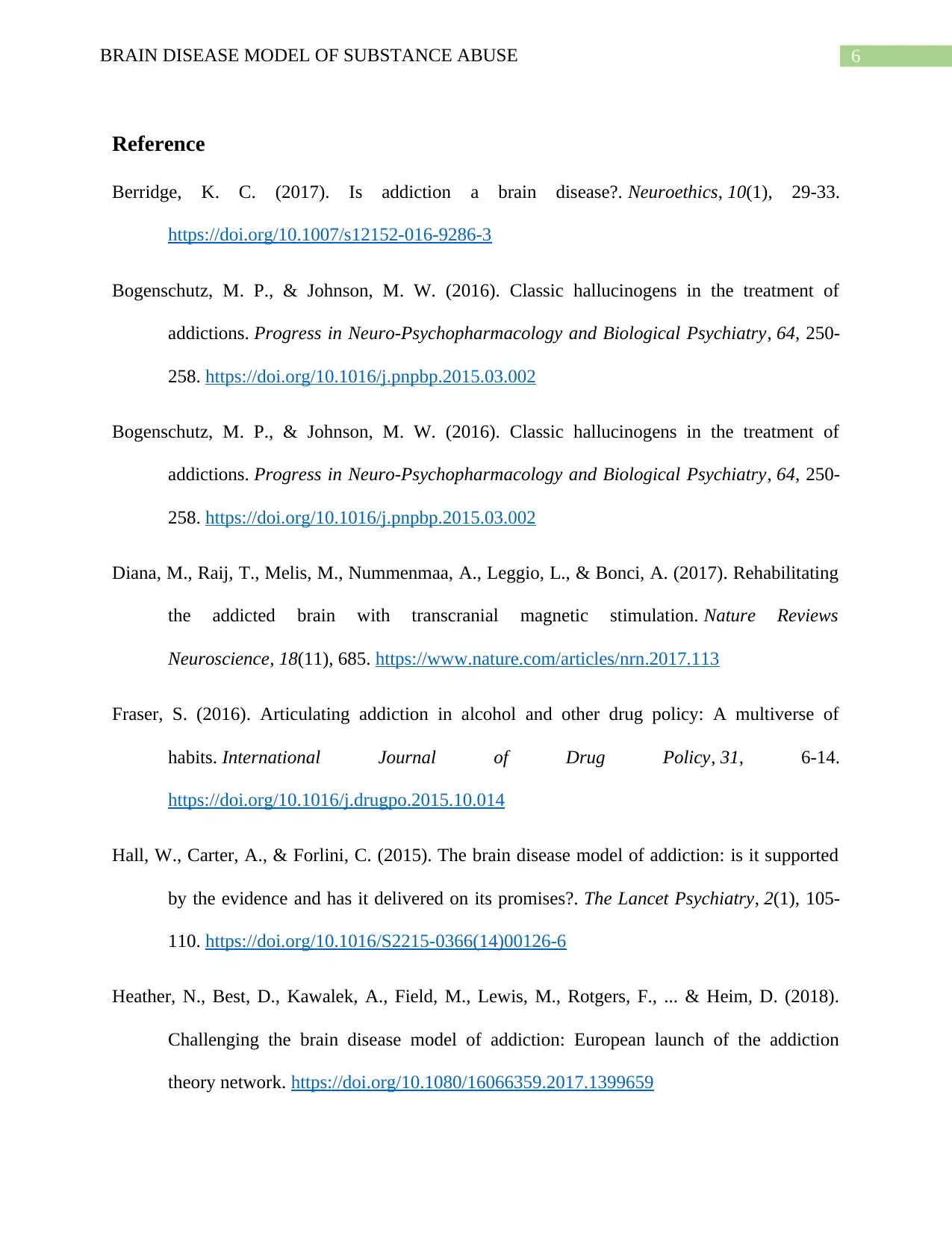
6BRAIN DISEASE MODEL OF SUBSTANCE ABUSE
Reference
Berridge, K. C. (2017). Is addiction a brain disease?. Neuroethics, 10(1), 29-33.
https://doi.org/10.1007/s12152-016-9286-3
Bogenschutz, M. P., & Johnson, M. W. (2016). Classic hallucinogens in the treatment of
addictions. Progress in Neuro-Psychopharmacology and Biological Psychiatry, 64, 250-
258. https://doi.org/10.1016/j.pnpbp.2015.03.002
Bogenschutz, M. P., & Johnson, M. W. (2016). Classic hallucinogens in the treatment of
addictions. Progress in Neuro-Psychopharmacology and Biological Psychiatry, 64, 250-
258. https://doi.org/10.1016/j.pnpbp.2015.03.002
Diana, M., Raij, T., Melis, M., Nummenmaa, A., Leggio, L., & Bonci, A. (2017). Rehabilitating
the addicted brain with transcranial magnetic stimulation. Nature Reviews
Neuroscience, 18(11), 685. https://www.nature.com/articles/nrn.2017.113
Fraser, S. (2016). Articulating addiction in alcohol and other drug policy: A multiverse of
habits. International Journal of Drug Policy, 31, 6-14.
https://doi.org/10.1016/j.drugpo.2015.10.014
Hall, W., Carter, A., & Forlini, C. (2015). The brain disease model of addiction: is it supported
by the evidence and has it delivered on its promises?. The Lancet Psychiatry, 2(1), 105-
110. https://doi.org/10.1016/S2215-0366(14)00126-6
Heather, N., Best, D., Kawalek, A., Field, M., Lewis, M., Rotgers, F., ... & Heim, D. (2018).
Challenging the brain disease model of addiction: European launch of the addiction
theory network. https://doi.org/10.1080/16066359.2017.1399659
Reference
Berridge, K. C. (2017). Is addiction a brain disease?. Neuroethics, 10(1), 29-33.
https://doi.org/10.1007/s12152-016-9286-3
Bogenschutz, M. P., & Johnson, M. W. (2016). Classic hallucinogens in the treatment of
addictions. Progress in Neuro-Psychopharmacology and Biological Psychiatry, 64, 250-
258. https://doi.org/10.1016/j.pnpbp.2015.03.002
Bogenschutz, M. P., & Johnson, M. W. (2016). Classic hallucinogens in the treatment of
addictions. Progress in Neuro-Psychopharmacology and Biological Psychiatry, 64, 250-
258. https://doi.org/10.1016/j.pnpbp.2015.03.002
Diana, M., Raij, T., Melis, M., Nummenmaa, A., Leggio, L., & Bonci, A. (2017). Rehabilitating
the addicted brain with transcranial magnetic stimulation. Nature Reviews
Neuroscience, 18(11), 685. https://www.nature.com/articles/nrn.2017.113
Fraser, S. (2016). Articulating addiction in alcohol and other drug policy: A multiverse of
habits. International Journal of Drug Policy, 31, 6-14.
https://doi.org/10.1016/j.drugpo.2015.10.014
Hall, W., Carter, A., & Forlini, C. (2015). The brain disease model of addiction: is it supported
by the evidence and has it delivered on its promises?. The Lancet Psychiatry, 2(1), 105-
110. https://doi.org/10.1016/S2215-0366(14)00126-6
Heather, N., Best, D., Kawalek, A., Field, M., Lewis, M., Rotgers, F., ... & Heim, D. (2018).
Challenging the brain disease model of addiction: European launch of the addiction
theory network. https://doi.org/10.1080/16066359.2017.1399659
Paraphrase This Document
Need a fresh take? Get an instant paraphrase of this document with our AI Paraphraser
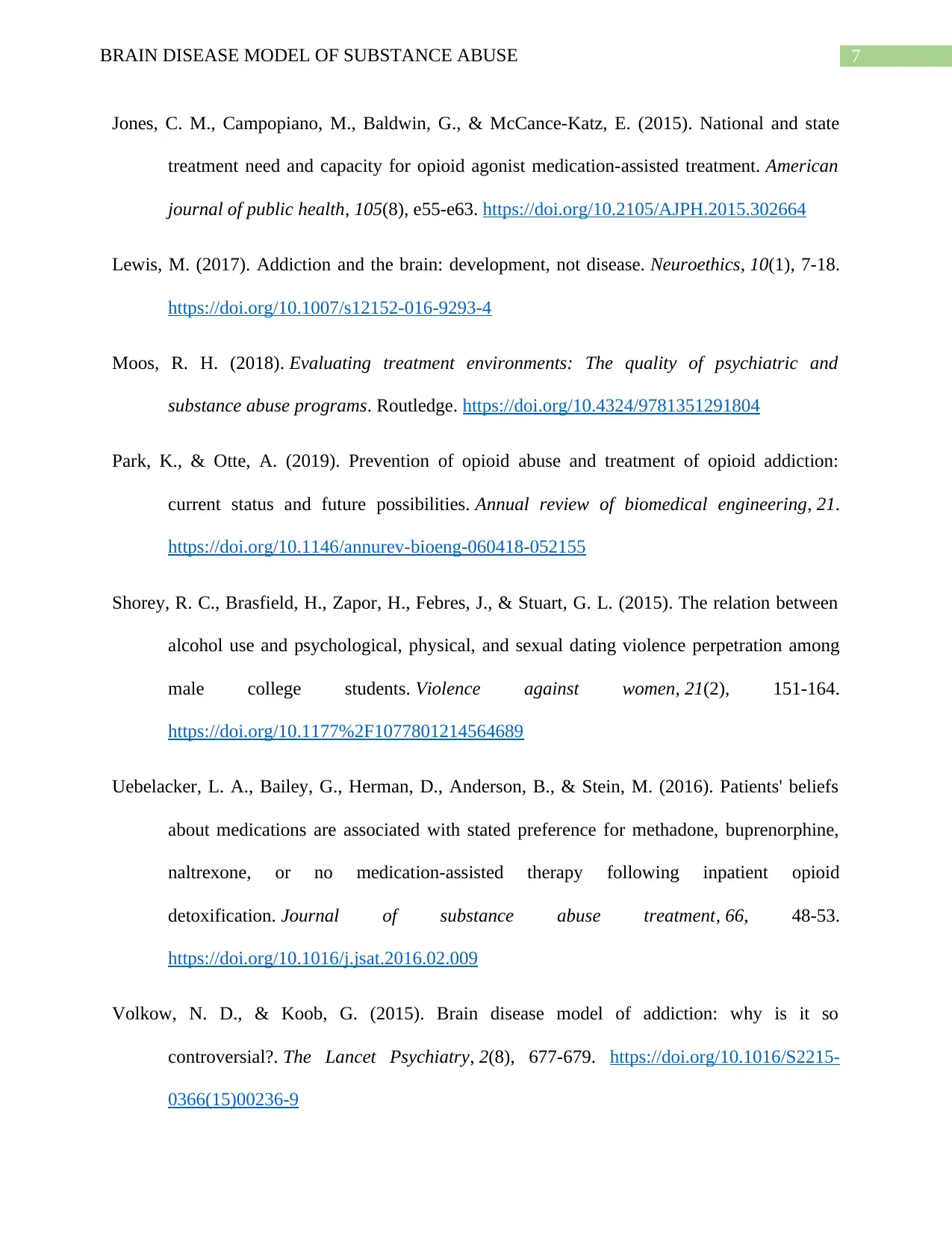
7BRAIN DISEASE MODEL OF SUBSTANCE ABUSE
Jones, C. M., Campopiano, M., Baldwin, G., & McCance-Katz, E. (2015). National and state
treatment need and capacity for opioid agonist medication-assisted treatment. American
journal of public health, 105(8), e55-e63. https://doi.org/10.2105/AJPH.2015.302664
Lewis, M. (2017). Addiction and the brain: development, not disease. Neuroethics, 10(1), 7-18.
https://doi.org/10.1007/s12152-016-9293-4
Moos, R. H. (2018). Evaluating treatment environments: The quality of psychiatric and
substance abuse programs. Routledge. https://doi.org/10.4324/9781351291804
Park, K., & Otte, A. (2019). Prevention of opioid abuse and treatment of opioid addiction:
current status and future possibilities. Annual review of biomedical engineering, 21.
https://doi.org/10.1146/annurev-bioeng-060418-052155
Shorey, R. C., Brasfield, H., Zapor, H., Febres, J., & Stuart, G. L. (2015). The relation between
alcohol use and psychological, physical, and sexual dating violence perpetration among
male college students. Violence against women, 21(2), 151-164.
https://doi.org/10.1177%2F1077801214564689
Uebelacker, L. A., Bailey, G., Herman, D., Anderson, B., & Stein, M. (2016). Patients' beliefs
about medications are associated with stated preference for methadone, buprenorphine,
naltrexone, or no medication-assisted therapy following inpatient opioid
detoxification. Journal of substance abuse treatment, 66, 48-53.
https://doi.org/10.1016/j.jsat.2016.02.009
Volkow, N. D., & Koob, G. (2015). Brain disease model of addiction: why is it so
controversial?. The Lancet Psychiatry, 2(8), 677-679. https://doi.org/10.1016/S2215-
0366(15)00236-9
Jones, C. M., Campopiano, M., Baldwin, G., & McCance-Katz, E. (2015). National and state
treatment need and capacity for opioid agonist medication-assisted treatment. American
journal of public health, 105(8), e55-e63. https://doi.org/10.2105/AJPH.2015.302664
Lewis, M. (2017). Addiction and the brain: development, not disease. Neuroethics, 10(1), 7-18.
https://doi.org/10.1007/s12152-016-9293-4
Moos, R. H. (2018). Evaluating treatment environments: The quality of psychiatric and
substance abuse programs. Routledge. https://doi.org/10.4324/9781351291804
Park, K., & Otte, A. (2019). Prevention of opioid abuse and treatment of opioid addiction:
current status and future possibilities. Annual review of biomedical engineering, 21.
https://doi.org/10.1146/annurev-bioeng-060418-052155
Shorey, R. C., Brasfield, H., Zapor, H., Febres, J., & Stuart, G. L. (2015). The relation between
alcohol use and psychological, physical, and sexual dating violence perpetration among
male college students. Violence against women, 21(2), 151-164.
https://doi.org/10.1177%2F1077801214564689
Uebelacker, L. A., Bailey, G., Herman, D., Anderson, B., & Stein, M. (2016). Patients' beliefs
about medications are associated with stated preference for methadone, buprenorphine,
naltrexone, or no medication-assisted therapy following inpatient opioid
detoxification. Journal of substance abuse treatment, 66, 48-53.
https://doi.org/10.1016/j.jsat.2016.02.009
Volkow, N. D., & Koob, G. (2015). Brain disease model of addiction: why is it so
controversial?. The Lancet Psychiatry, 2(8), 677-679. https://doi.org/10.1016/S2215-
0366(15)00236-9
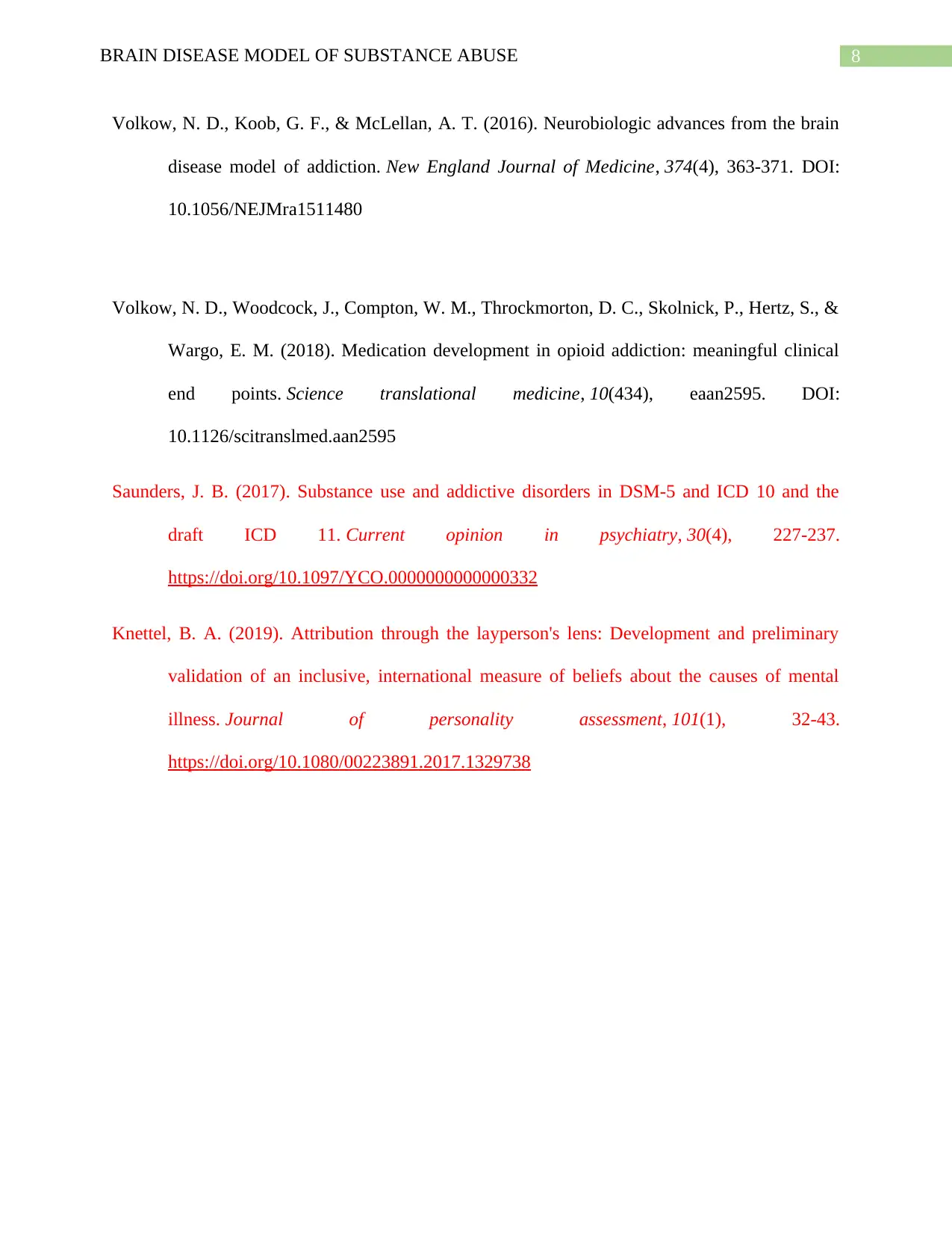
8BRAIN DISEASE MODEL OF SUBSTANCE ABUSE
Volkow, N. D., Koob, G. F., & McLellan, A. T. (2016). Neurobiologic advances from the brain
disease model of addiction. New England Journal of Medicine, 374(4), 363-371. DOI:
10.1056/NEJMra1511480
Volkow, N. D., Woodcock, J., Compton, W. M., Throckmorton, D. C., Skolnick, P., Hertz, S., &
Wargo, E. M. (2018). Medication development in opioid addiction: meaningful clinical
end points. Science translational medicine, 10(434), eaan2595. DOI:
10.1126/scitranslmed.aan2595
Saunders, J. B. (2017). Substance use and addictive disorders in DSM-5 and ICD 10 and the
draft ICD 11. Current opinion in psychiatry, 30(4), 227-237.
https://doi.org/10.1097/YCO.0000000000000332
Knettel, B. A. (2019). Attribution through the layperson's lens: Development and preliminary
validation of an inclusive, international measure of beliefs about the causes of mental
illness. Journal of personality assessment, 101(1), 32-43.
https://doi.org/10.1080/00223891.2017.1329738
Volkow, N. D., Koob, G. F., & McLellan, A. T. (2016). Neurobiologic advances from the brain
disease model of addiction. New England Journal of Medicine, 374(4), 363-371. DOI:
10.1056/NEJMra1511480
Volkow, N. D., Woodcock, J., Compton, W. M., Throckmorton, D. C., Skolnick, P., Hertz, S., &
Wargo, E. M. (2018). Medication development in opioid addiction: meaningful clinical
end points. Science translational medicine, 10(434), eaan2595. DOI:
10.1126/scitranslmed.aan2595
Saunders, J. B. (2017). Substance use and addictive disorders in DSM-5 and ICD 10 and the
draft ICD 11. Current opinion in psychiatry, 30(4), 227-237.
https://doi.org/10.1097/YCO.0000000000000332
Knettel, B. A. (2019). Attribution through the layperson's lens: Development and preliminary
validation of an inclusive, international measure of beliefs about the causes of mental
illness. Journal of personality assessment, 101(1), 32-43.
https://doi.org/10.1080/00223891.2017.1329738
⊘ This is a preview!⊘
Do you want full access?
Subscribe today to unlock all pages.

Trusted by 1+ million students worldwide
1 out of 9
Related Documents
Your All-in-One AI-Powered Toolkit for Academic Success.
+13062052269
info@desklib.com
Available 24*7 on WhatsApp / Email
![[object Object]](/_next/static/media/star-bottom.7253800d.svg)
Unlock your academic potential
Copyright © 2020–2025 A2Z Services. All Rights Reserved. Developed and managed by ZUCOL.




